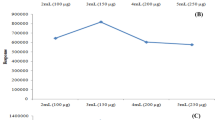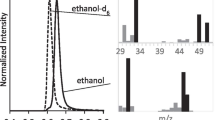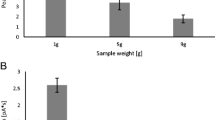Abstract
A method for analyzing the contents of residual hexane in health functional food products was developed. The dissolving solvents in the health functional food products and the internal standard selected were N,N-dimethylacetamide and heptane, respectively. The analysis conditions for headspace-gas chromatography/flame ionization detection (HS-GC/FID) and headspace-gas chromatography/mass spectrometry (HS-GC/MS) were determined as 18 mL of headspace volume, 100°C of headspace oven temperature, and 30 min of equilibration time; a Durabond (DB)-624 column was selected for this analysis. To validate this method, which applies N,N-dimethylacetamide as a dissolving solvent, the limit of detection and limit of quantification (LOQ) values based on the HS-GC/FID and HS-GC/MS analyses results were found to be 0.10, 0.29 and 0.16, 0.47 mg/L, respectively. The recoveries and coefficient of variation (CV) obtained by HS-GC/MS were 96.39–119.86% and 0.04–1.25%, respectively, better than those obtained by HS-GC/FID. By applying the HS-GC/MS method, it was possible to analyze the content of the residual hexane in 60 different types of health functional food products.
Similar content being viewed by others
References
Korea Food Industry Association. Food Additives Code. Kyung Sung Culture Co., Seoul, Republic of Korea. p. 1426 (2016)
Food and Agriculture Organization of the United Nations. Hexanes. Available from: http://www.fao.org/food/food-safety-quality/scientific-advice/jecfa/jecfa-additives/en/. Accessed Feb. 24, 2016
Oh CH, Kwon YK, Jang YM, Lee DS, Park JS. Headspace analysis for residual hexane in vegetable oil. Food Sci. Biotechnol. 14: 456–460 (2005)
Antolín EM, Quiñónez YB, Canavaciolo VG, Cruz ER. Validation of an analytical method for quality control of residual solvents (n-hexane and acetone) in D-002: New active ingredient from beeswax. J. Pharmaceut. Biomed. 47: 646–650 (2008)
Ito Y, Ishizuki K, Sekiguchi W, Tada A, Akiyama T, Sato K, Yamazaki T, Akiyama H. Analysis of residual solvents in annatto extracts using a static headspace gas chromatography method. Am. J. Anal. Chem. 3: 638–645 (2012)
Cheng C, Liu S, Mueller BJ, Yan Z. A generic static headspace gas chromatography method for determination of residual solvents in drug substance. J. Chromatogr. A 1217: 6413–6421 (2010)
Kim NS, Lee JH, Heo OS, Lee KT. Study of the presence of residual hexane on olive oils. J. Korean Soc. Food Sci. Nutr. 35: 1405–1411 (2006)
Rocheleau MJ, Titley M, Bolduc J. Measuring residual solvents in pharmaceutical samples using fast gas chromatography techniques. J. Chromatogr. B 805: 77–86 (2004)
Plutowska B, Wardencki W. Aromagrams–Aromatic profiles in the appreciation of food quality. Food Chem. 101: 845–872 (2007)
Witschi C, Doelker E. Residual solvents in pharmaceutical products: Acceptable limits, influences on physicochemical properties, analytical methods and documented values. Eur. J. Pharm. Biopharm. 43: 215–242 (1997)
Akapo SO, McCrea CM. SPME-GC determination of potential volatile organic leachables in aquous-based pharmaceutical formulations packaged in overwrapped LDPE vials. J. Pharmaceut. Biomed. 47: 526–534 (2008)
Kumar N, Gow JG. Residual solvent analysis by headspace gas chromatography. J. Chromatogr. A 667: 235–240 (1994)
Lorenzo IM, Racon JLP, Lespada MEF, Pinto CG, Cordero BM. Detection of adulterants in olive oil by headspace-mass chromatography. J. Chromatogr. A 945: 221–230 (2002)
Urakami K, Higashi A, Umemoto K, Godo M. Matrix media selection for the determination of residual solvents in pharmaceuticals by static headspace gas chromatography. J. Chromatogr. A 1057: 203–210 (2004)
Ramos C. Development and validation of a headspace gas chromatographic method for determination of residual solvents in five drug substances. Int. J. Pharm. Sci. 2: 36–41 (2013)
Author information
Authors and Affiliations
Corresponding author
Rights and permissions
About this article
Cite this article
Jeong, EJ., Lee, S.H., Kim, BT. et al. An analysis method for determining residual hexane in health functional food products using static headspace gas chromatography. Food Sci Biotechnol 26, 363–368 (2017). https://doi.org/10.1007/s10068-017-0049-7
Received:
Revised:
Accepted:
Published:
Issue Date:
DOI: https://doi.org/10.1007/s10068-017-0049-7




